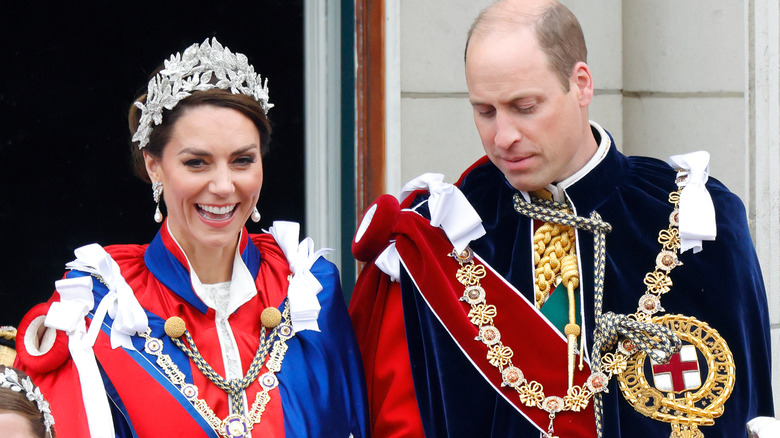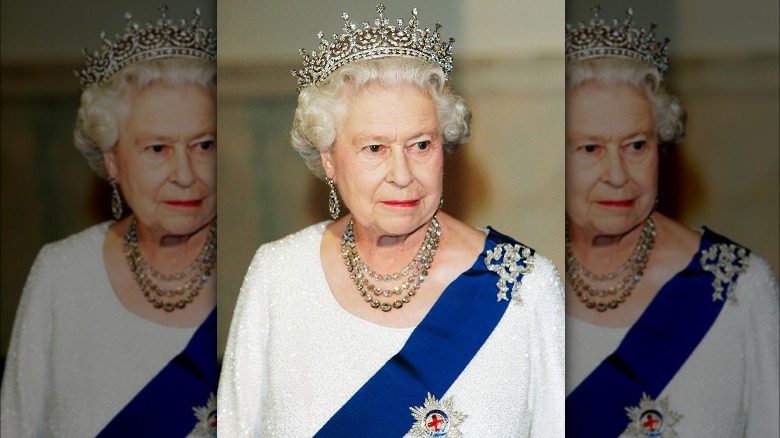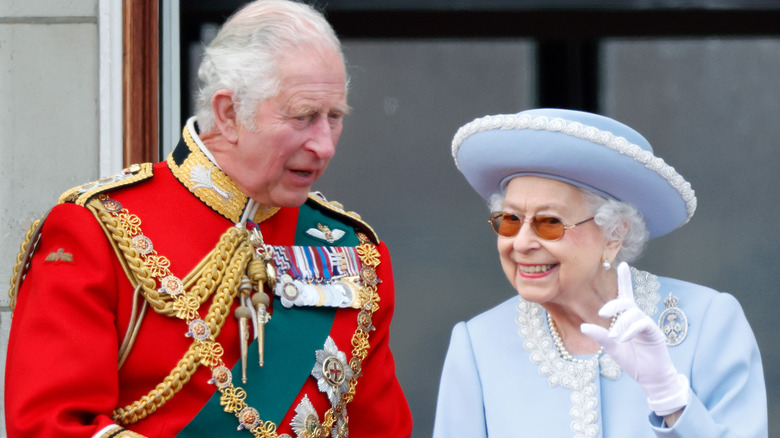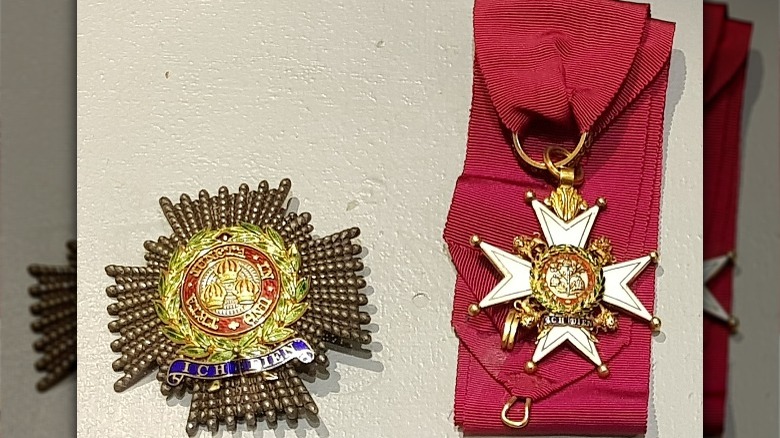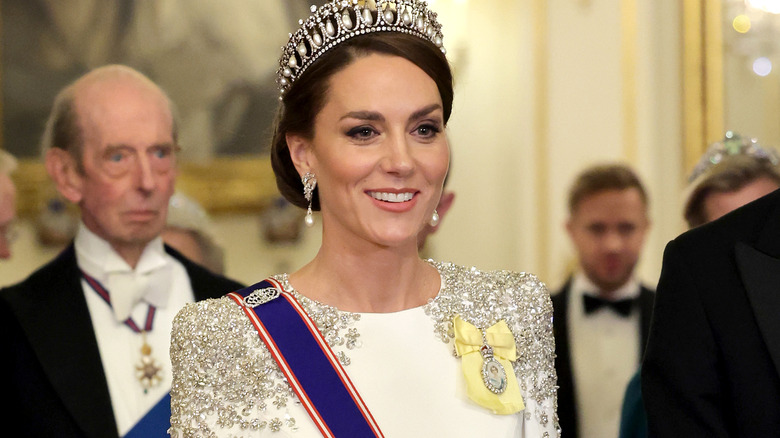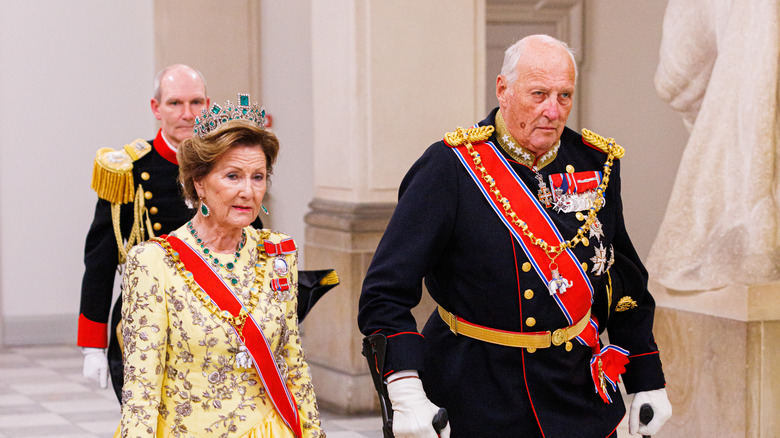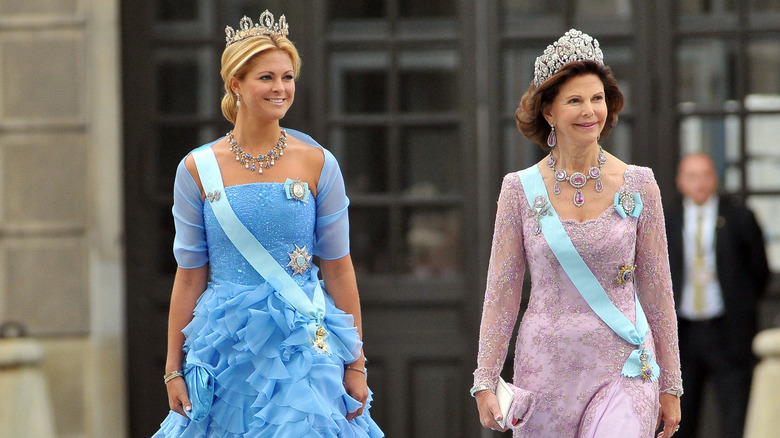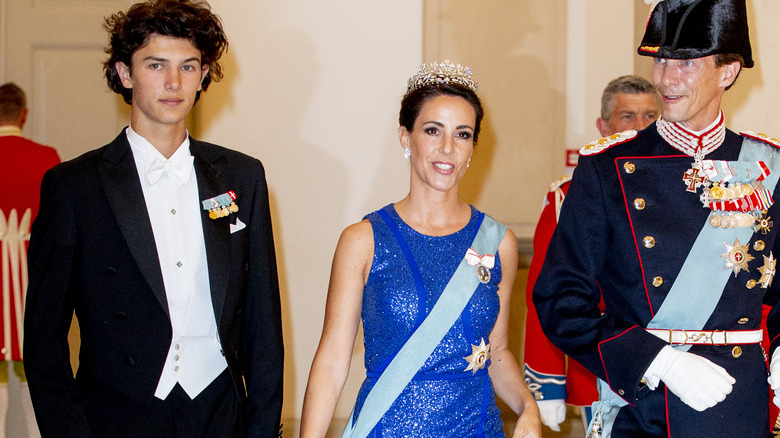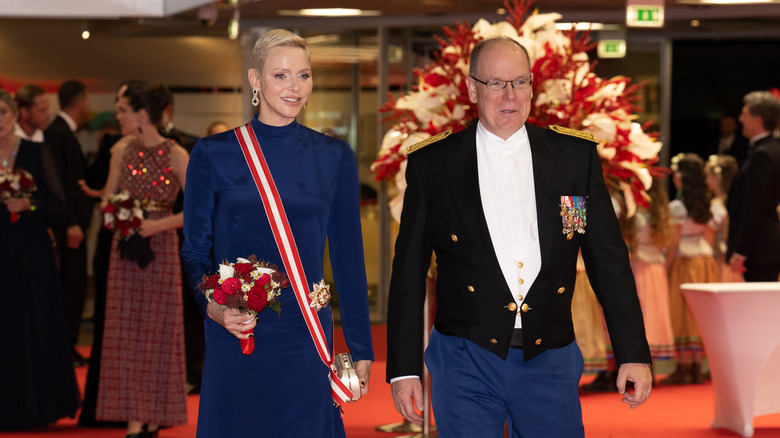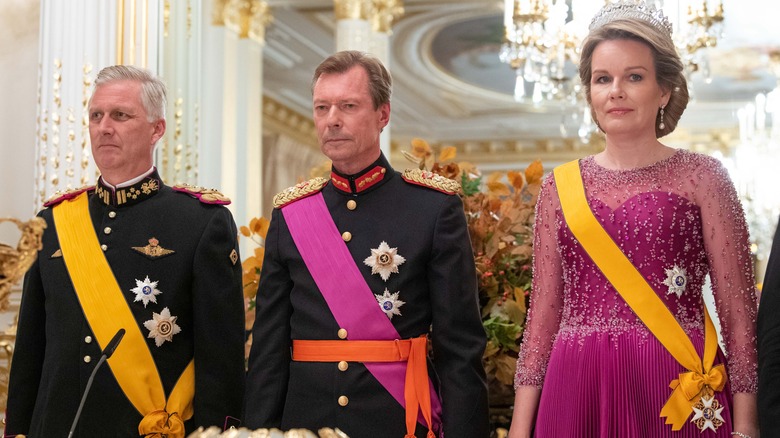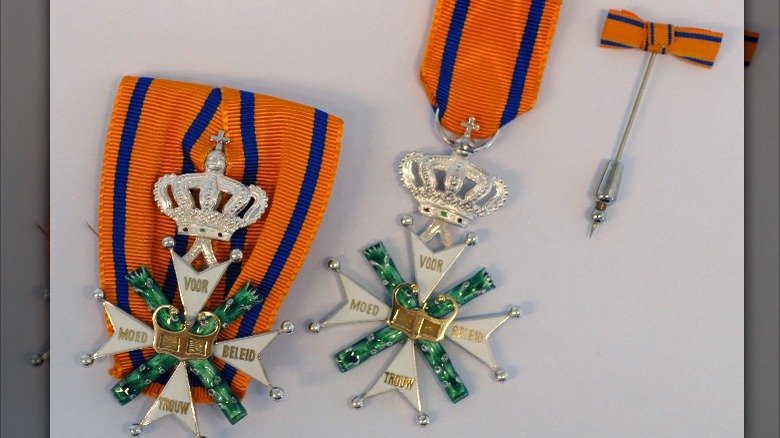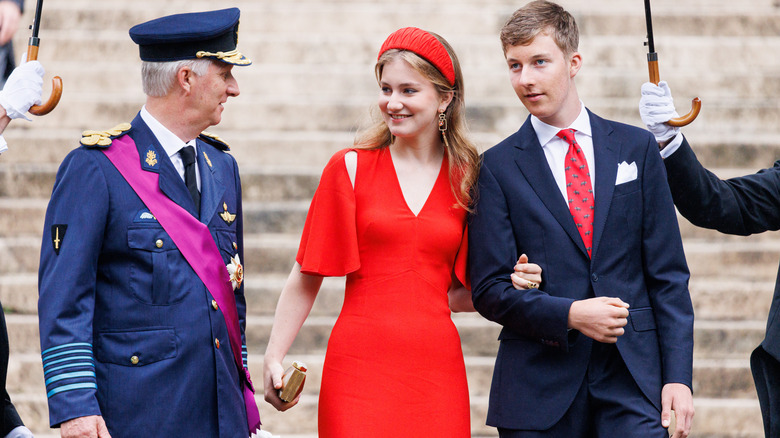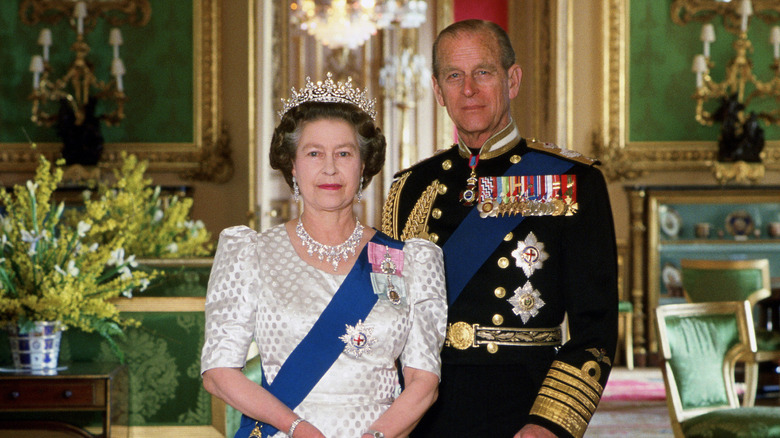Sashes Worn By Royal Families Explained
It's easy to get lost in the glamor of the royal family, from the crown jewels to the stunning dresses to the colorful sashes. Yet, have you ever wondered what all those different sashes worn by royal families around the world mean? The British royal family alone has blue, red, and green sashes for different occasions.
The sashes, called ribands, represent the different orders within a royal family. Most of these are part of each monarchy's Order of Chivalry and go back centuries into the family's history. However, some royal orders are new to the game and given to those that help or contribute to the crown or county in some magnanimous way. Generally, each royal family's highest and most noble order is given to the king, their family, and heads of state. In addition to a sash, the royals and knights have other insignia that illustrate their elevated status, including badges and collars.
Explore the different ribands of the British monarchy and other monarchies found throughout Europe. Get a glimpse at the different rules for wearing the various insignia.
Order of the Garter
The Most Noble Order of the Garter is one of the most well-known sashes to grace the pages of tabloids and entertainment. The distinctive royal blue sash can be seen gracing the shoulders of dashing British royals like King Charles III and Prince William. The Order of the Garter has a long and lavish history that dates back to medieval times and King Edward III, who reigned in the 1300s, and his love of Arthurian legends of knights and chivalry.
According to The Royal Household, the Order of the Garter is one of the oldest orders within the Order of Chivalry in Britain, and it includes the royal family and 24 knights, which are chosen by the sovereign among those with significant achievements for the country. In addition to the royal blue sash, those inducted into the Order of the Garter are also seen wearing a metal badge with the arms of Saint George and the motto of the Order, "Honi soit qui mal y pense" ("Shame on him who thinks this evil").
During the celebration of the Most Noble Order of the Garter, you might also see your favorite British royals wearing plumed hats and lavish robes. While the Most Noble Order of the Garter is the highest rank a British royal can achieve, it's one of more than a dozen orders within the royal court. Therefore, you'll also see the Order of the Thistle riband in addition to the iconic blue sash.
Order of the Thistle
You might have noticed that royal blue isn't the only color in which those British royals get decked out on occasion. In addition to the royal blue sash, King Charles III dons a distinct deep green sash of the Most Ancient and Most Noble Order of the Thistle of Scotland. Unlike the Order of the Garter, which is reserved for the royal family and a few chosen knights, the green sash of the Order of the Thistle can be given out as a personal gift by the king to 16 knights and exemplary Scottish citizens.
The Order of the Thistle's true origins are unknown; however, it's thought to date back to before the Order of the Garter. What is known about this regal Scottish Order is that James III revamped it into its modern-day custom in 1687. According to The Royal Household, the Order is recognized by its distinct green sash and a badge depicting Saint Andrew with the motto, "Nemo me impune lacessit" ("No one harms me with impunity").
While you aren't going to see the royals wearing the Order of the Thistle sash as often as the Order of the Garter gear, you'll see the British royals wearing their finest green robes and white-plumed hats every other year to install new knights. Another common riband lining the shoulders of the House of Windsor is the Order of the Bath.
Order of the Bath
Crimson is found in the heart of those patriots ready to give their all for their country, which makes it a fitting color for the sash of the Most Honourable Order of the Bath. In addition to a red crimson sash or velvet robe, members of this Order wear a badge with three crowns and the moto "Tria juncta in uno" ("Three joined in one"), according to The Central Chancery of the Orders of Knighthood.
The Order was founded in 1725 by the Letters Patent of George I as a way to honor the brave knights and civilians that give their all for their county. Interestingly the name comes from how the knights were purified in water through a ritual bath, hence the Order of the Bath. Currently, the Order has six different Officers of the Order, of which King Charles III is the leader as the sovereign, although he held the position of Great Master until 2022, stated Westminster Abbey
Historically, the Order only admitted men until 1971. But, Princess Alice, Duchess of Gloucester, changed all that by becoming installed into one of the 34 stalls available and among the ranks of famous generals like Admiral Nelson, the Duke of Wellington, and Viscount Montgomery of Alamein. When it comes to those that serve their country, you can't forget the working royals to earn this next sash.
The Royal Victorian Order
It's hard not to be glued to the lives of the British royal family, especially Prince William, Princess Catherine, and their adorable children. If you are a royal family junkie, then you've probably already watched as the Princess of Wales received her installment into the Royal Victorian Order in 2019 when she was recognized for personal service by the former Queen Elizabeth II, joining the ranks of other known royals like the Countess of Wessex.
The distinction of The Royal Victorian Order is the bold blue sash edged with white and red and the badge with a Maltese cross and royal cypher. Unlike some orders that require the Prime Minister's approval, this distinguished Order, established in 1896 by Queen Victoria, can be given by the sovereign at their discretion, according to The Central Chancery of the Orders of Knighthood. While the Order has several different distinctions, Princess Catherine was bestowed with one of the highest as Dame Grand Cross during her induction. This royal followed a long line of women bestowed with this honor, including the first woman in the Order's history Queen Mary in 1936, according to The Court Jeweller. It's time to leave the British court to explore the Norwegian sash.
Order of St. Olav
For centuries, royal houses have been led by structure, meaning those famous British royals aren't the only ones standing around in their brilliant sashes. Other royal houses have their own chivalrous colors designating them the sovereigns of their nation. Following the colors of the Norwegian flag, the bright red sash edged with a bold blue stripe surrounded in white on either side is the Royal Norwegian Order of St. Olav. The sash is also adorned with the Insignia of the Order, which includes a Maltese cross encircled by a blue and white ring with the Norwegian lion, according to The Royal House of Norway.
The Order was founded in 1847 by King Oscar I, and is broken down into five classes from Grand Cross to Knight. As of 2023, you can easily see the sash on Her Majesty Queen Sonja, her family, and those that they've deemed to provide Norway with exemplary service. Much like the sashes of the British monarchs, only so many are made available, and they must be returned upon death.
When royals get together, they like to make a splash of color, and their ribands allow you to know just who they are. Just a hop, skip, and jump from Norway, Sweden offers a distinct Order of Chivalry with a baby blue hue.
Order of the Seraphim
When you think of the Royal Order of the Seraphim, remember it's Sweden's version of the Order of the Garter. Symbolized by a bright baby blue sash worn over the right shoulder, the Order came to fruition in 1748 by King Fredrik I of Sweden, and it's one of four of Sweden's Orders of His Majesty.
Contrasting themselves to the famous British highest Order of Chivalry, the Swedish Order only has one class, which is that of the knight. The sash is adorned with a unique badge featuring a star and the letters IHS, which stands for "Iesus Hominum Salvator" ("Jesus, Saviour of Mankind"), according to the Tallinn Museum of Orders of Knights. The museum noted this distinction was given to knights that watched over the sick, homeless, poor, and orphaned around Sweden, including those in the Seraphim Hospital, leading to its name.
Over time, the composition of the Order has changed from knights watching over the people to distinguishing the Swedish royals and specific foreign state heads. Knighthoods are reserved for distinguished citizens of Sweden who join the Order of Vasa and Order of the Sword, stated Royal Central.
Order of the Elephant
Every order has its own unique history and famous royals; however, Denmark's Order of the Elephant is rich and vast, with the official written statues dating back to 1693. However, the legacy of this order goes back much further, possibly earlier than the 1400s (via Kongehuset). Additionally, one of the famous recipients of the Order of the Elephant was Napoleon Bonaparte, who was installed with the honor in 1808, stated Napoleon.org.
If the white elephant with gold fringe and an eight-pointed star weren't enough to give away the distinct look of this chivalric honor, the powder blue sash is another clue that you're looking at Danish royals. The Order of the Elephant is the highest order in Denmark and only bestowed upon the royals and heads of state, like Queen Margrethe II and her sons. One of two Orders of Chivalry in Denmark, the queen has only given out around 70 installments during her reign; however, Kongehuset notes that nearly 900 installs have been made in the Order's history.
You might also see the elephant worn on a collar instead of a sash, but this only happens three times a year. Therefore, it's much more common to see a princess flashing that beautiful blue riband. While you might see the Denmark royals in the news due to the sibling's rocky relationship, the next sash flies under the radar.
Order of Saint-Charles
The tiny Principality of Monaco might not make the news very often, but the sovereign city-state takes its royal Orders seriously. Monaco's highest Order of Chivalry is the Order of Saint-Charles, which is noted by the red sash with a white strip down it and white edges, like the colors of Monaco's flag. The badge features a wreath of laurel leaves on a Maltese cross and the motto, "Princeps et Patria" ("prince and country"), according to The Court Jeweller.
The order was founded in 1858 by Charles III of Monaco; however, its name comes from Saint Charles Borromeo, a patron saint of the 16th century that was Charles III's own personal saint (via The Court Jeweller). Like the other highest orders worldwide, the Order of Saint Charles is headed and bestowed by the current monarch, which is why Prince Albert II is the Grand Master. Beyond the sovereign's role, five other ranks are available to citizens and foreign nationals recognized for their dedication to the prince or state.
The Order of Saint Charles is one of three honors offered by the Monaco government for its commitment and dedication to the country. You've seen vines, crowns, and elephants, so it's time to enjoy the golden lion of the House of Nassau.
Order of the Golden Lion of the House of Nassau
The history behind the Order of the Golden Lion of the House of Nassau is a bit more complicated than your typical Order; however, it's distinguished by an eight-pointed star, a gold lion badge, and a gold sash with faint blue edges. It's the highest chivalric Order of the two parts of the House of Nassau and awarded to royalty and head of state alike.
Unlike some Orders that go back to the 16th century, the history of the Order of the Gold Lion of the House of Nassau goes back to 1858 and is shared between the two Houses of Nassau, meaning both the Grand Duke and monarch of the Netherlands are Grand Masters (via Royal House of the Netherlands), showing their commitment to unity between the two nations. It, along with the Order of Civil and Military Merit of Adolphe of Nassau, is given out to those loyal to the Grand Duke of Luxembourg, Henri, who became head of state in 2000.
Since the gold sash of Luxembourg distinguishes the House of Nassau, it's time to look at the sash of the Order of the House of Orange-Nassau.
Military Order of William
You can't explore the royal sashes from around the world without checking out the other House of Nassau: the Orange-Nassau, which is the Royal House of the Netherlands. The highest and most noble order found within the Netherlands' honors is the Military Order of William.
Signed by the Grand Master of the Orders, the king, this order is given to those with distinguished military achievements and comes in four knight classes: grand cross, commander, third class, and fourth class. Honorees of this award wear an orange sash with bold blue along the edges and a badge of harrowing bravery, leadership, and devotion. During a tumultuous time in Netherlands' history, Willem I created the order in 1815 to commemorate and honor those that helped to keep the Kingdom of the Netherlands together. Unlike most noble orders of the highest level, this order doesn't require recipients to be of royal blood, which is one of the reasons it's been bestowed on more than 6,000 recipients, according to Kanselarij Der Nederlandse Orden.
With the different Houses of Nassau in order, the Belgium order takes center stage. See how the sash of the Order of Leopold I shines amongst the crowd.
Order of Leopold I
You can easily pick King Philippe of Belgium out of a crowd by looking for his sash of majestic purple. The sash draped around the king and his wife, Queen Mathilde, is the highest honor established for those with military, maritime, or civil excellence, the Order of Leopold I. In addition to the eye-catching color, the badge features a white cross decorated in laurel and oak wreath, stated the Association of the Order of Leopold.
The honor, established in 1832, is named after the first official king of Belgium and is structured like most royal Orders with rankings for the Grand Officer, Knights, Officers, Commanders, and Grand Ribbon holders, noted the Association. While it's the highest honor of the Belgium royalty, it's just one of three orders, including the Order of the Crown and the Order of Leopold II.
It's hard to miss a royal sash draped around a king or queen as they greet the crowd or attend a family function. It's just as much a part of their attire as their tiara or their metals. But just like the royal jewels, there's a structure for wearing your riband.
The etiquette of wearing a riband
The act of getting a sash differs by country, but typically military prowess and service to the crown are rewarded. Additionally, many royals are typically born a member of the highest order, given their royal bloodline. However, like everything else within the royal court, there are specific rules to how and when you wear a royal sash and badge.
Typically, royal sashes are worn to royal functions where the royal collar isn't necessary. For example, the sash might be worn to an official banquet or any event that calls for the wearing of your royal insignia. The sashes are worn over the shoulder and secured at the hip. Now the shoulder they are worn over can vary based on the region or royal house. For example, the British Order of the Garter sash is worn over the left shoulder and pinned at the right hip, while the Belgium sash is worn on the opposite shoulder.
Royal life is full of color, especially if you start to check out all their different sashes. These colorful ribands are used to signify different leaders of the house and chivalric orders, and they're as much a part of the royal ensemble as a suit or tiara.
